
Fernando Villaamil
Encyclopedia
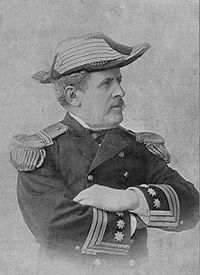
Spanish people
The Spanish are citizens of the Kingdom of Spain. Within Spain, there are also a number of vigorous nationalisms and regionalisms, reflecting the country's complex history....
naval officer, remembered for his internationally recognized professionalism, for being the designer of the first destroyer
Destroyer
In naval terminology, a destroyer is a fast and maneuverable yet long-endurance warship intended to escort larger vessels in a fleet, convoy or battle group and defend them against smaller, powerful, short-range attackers. Destroyers, originally called torpedo-boat destroyers in 1892, evolved from...
warship in history and for his heroic death in the naval Battle of Santiago de Cuba
Battle of Santiago de Cuba
The Battle of Santiago de Cuba, fought between Spain and the United States on 3 July 1898, was the largest naval engagement of the Spanish-American War and resulted in the destruction of the Spanish Navy's Caribbean Squadron.-Spanish Fleet:...
of the Spanish-American war
Spanish-American War
The Spanish–American War was a conflict in 1898 between Spain and the United States, effectively the result of American intervention in the ongoing Cuban War of Independence...
, being the highest ranking Spanish officer to suffer this fate in that event.
The origins
Fernando Villaamil was born in Serantes, near CastropolCastropol
-Parishes:It has nine parishes :* Balmonte* Barres* Castropol* Figueras* Moldes* Piñera* Presno* Seares* Tol...
(Asturias
Asturias
The Principality of Asturias is an autonomous community of the Kingdom of Spain, coextensive with the former Kingdom of Asturias in the Middle Ages...
), in the north of Spain, less than a mile from the Bay of Biscay
Bay of Biscay
The Bay of Biscay is a gulf of the northeast Atlantic Ocean located south of the Celtic Sea. It lies along the western coast of France from Brest south to the Spanish border, and the northern coast of Spain west to Cape Ortegal, and is named in English after the province of Biscay, in the Spanish...
coastline. He descended from a family of respected noblemen and landowners, but his father found himself almost completely ruined, and had to sell all his property, including the family ancestral home . It seems that this event produced a strong mixed feeling of both affection and anger about his native region in Fernando, which would last for the rest of his life.
In 1861 he entered the Spanish Navy
Spanish Navy
The Spanish Navy is the maritime branch of the Spanish Armed Forces, one of the oldest active naval forces in the world. The Armada is responsible for notable achievements in world history such as the discovery of Americas, the first world circumnavigation, and the discovery of a maritime path...
Colegio Naval de San Fernando, and one year later he went, as midshipman, aboard the frigate Esperanza, the first of the long series of warships on which he would serve his nation until the final Furor
Spanish destroyer Furor
Furor was a Furor-class destroyer of the Spanish Navy that fought at the Battle of Santiago de Cuba during the Spanish-American War.-Technical characteristics:...
.
He then served in the Philippines
Philippines
The Philippines , officially known as the Republic of the Philippines , is a country in Southeast Asia in the western Pacific Ocean. To its north across the Luzon Strait lies Taiwan. West across the South China Sea sits Vietnam...
and Cuba
Cuba
The Republic of Cuba is an island nation in the Caribbean. The nation of Cuba consists of the main island of Cuba, the Isla de la Juventud, and several archipelagos. Havana is the largest city in Cuba and the country's capital. Santiago de Cuba is the second largest city...
, the last remains of the Spanish Empire
Spanish Empire
The Spanish Empire comprised territories and colonies administered directly by Spain in Europe, in America, Africa, Asia and Oceania. It originated during the Age of Exploration and was therefore one of the first global empires. At the time of Habsburgs, Spain reached the peak of its world power....
, and in 1873 he was back in Spain and was nominated as a teacher in the Naval School that the Spanish Navy held aboard a frigate anchored in the naval base of Ferrol. Along the following years Villaamil took advantage of the studying and writing opportunities presented by his new job, becoming one of the best known and respected Spanish Navy officers.
The Destructor
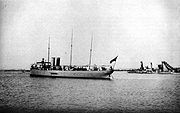
Once he reached his conclusions on the subject, he obtained the agreement of the Minister of the Navy, Manuel Pezuela, and selected the British shipyards of James & George Thompson
George Thomson (shipbuilder)
George Thomson was a Scottish marine engineer and shipbuilder, born at Partick, Glasgow.He served his apprenticeship with a Mr Graham in Partick before entering the works of Mr Robert Napier, where he quickly gained the best knowledge in marine engineering available.He then went into business with...
, in Clydebank
Clydebank
Clydebank is a town in West Dunbartonshire, in the Central Lowlands of Scotland. Situated on the north bank of the River Clyde, Clydebank borders Dumbarton, the town with which it was combined to form West Dunbartonshire, as well as the town of Milngavie in East Dunbartonshire, and the Yoker and...
to build the new vessel, beginning in late 1885.
Villaamil was assigned to Great Britain to supervise the works and study the operating procedures of the British naval dockyards, as well as the new Engineers corps. On January 19, 1887, the Destructor, the first torpedo boat destroyer, was formally handed over to the Spanish Navy, with great expectations from the European naval community.
On the 24 the ship, which had reached 22.5 knots (44.1 km/h) in the trials, weighed anchor in Falmouth
Falmouth, Cornwall
Falmouth is a town, civil parish and port on the River Fal on the south coast of Cornwall, England, United Kingdom. It has a total resident population of 21,635.Falmouth is the terminus of the A39, which begins some 200 miles away in Bath, Somerset....
, bounded for Vigo
Vigo
Vigo is a city and municipality in north-west Spain, in Galicia, situated on the ria of the same name on the Atlantic Ocean.-Population:...
, with Villaamil in command. Twenty-four hours later, she reached the Spanish coast, making 18 knots (35.3 km/h) through a stormy Bay of Biscay.
In one day the doubts about the ship seaworthiness were answered forever, and her designer and commander had every reason to feel proud. As a consequence of the success of the Destructor, Villaamil's professional reputation grew, both in Spain and abroad.
Around the world aboard the Nautilus
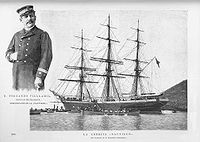
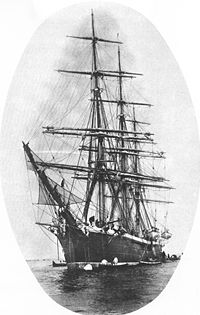
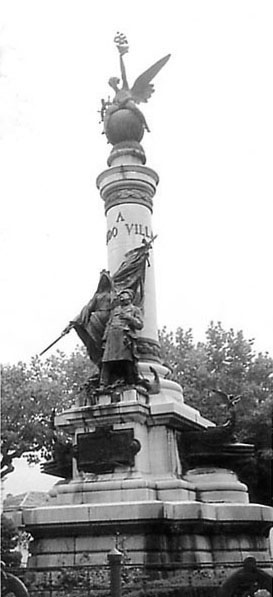
Corvette
A corvette is a small, maneuverable, lightly armed warship, originally smaller than a frigate and larger than a coastal patrol craft or fast attack craft , although many recent designs resemble frigates in size and role...
Nautilus he took advantage of the celebrations of the fourth centenary of America's discovery to get approval for an instruction cruise around the world
Circumnavigation
Circumnavigation – literally, "navigation of a circumference" – refers to travelling all the way around an island, a continent, or the entire planet Earth.- Global circumnavigation :...
, rounding the three Great Capes
Great capes
In sailing, the great capes are the three major capes of the Southern Ocean — the Cape of Good Hope , Cape Leeuwin, and Cape Horn. South East Cape of Tasmania and South West Cape at the southern tip of Stewart Island/Rakiura are also sometimes included as major landmarks of a circumnavigation...
.
On November 30, 1892
the Nautilus left Ferrol, in the northwest end of Spain. She rounded Cape Agulhas
Cape Agulhas
Cape Agulhas is a rocky headland in the Western Cape, South Africa. It is the geographic southern tip of Africa and the official dividing point between the Atlantic and Indian oceans...
and Cape Leeuwin
Cape Leeuwin
Cape Leeuwin is the most south-westerly mainland point of the Australian Continent, in the state of Western Australia.A few small islands and rocks, the St Alouarn Islands, extend further to the south. The nearest settlement, north of the cape, is Augusta. South-east of Cape Leeuwin, the coast...
, passed through Bass
Bass Strait
Bass Strait is a sea strait separating Tasmania from the south of the Australian mainland, specifically the state of Victoria.-Extent:The International Hydrographic Organization defines the limits of the Bass Strait as follows:...
and Cook
Cook Strait
Cook Strait is the strait between the North and South Islands of New Zealand. It connects the Tasman Sea on the west with the South Pacific Ocean on the east....
straits, rounded Cape Horn
Cape Horn
Cape Horn is the southernmost headland of the Tierra del Fuego archipelago of southern Chile, and is located on the small Hornos Island...
, went to New York
New York
New York is a state in the Northeastern region of the United States. It is the nation's third most populous state. New York is bordered by New Jersey and Pennsylvania to the south, and by Connecticut, Massachusetts and Vermont to the east...
and eventually, after sailing forty thousand miles, came back to Spain on a shining Sunday, July 16, 1894, in San Sebastián
San Sebastián
Donostia-San Sebastián is a city and municipality located in the north of Spain, in the coast of the Bay of Biscay and 20 km away from the French border. The city is the capital of Gipuzkoa, in the autonomous community of the Basque Country. The municipality’s population is 186,122 , and its...
.
Here the sailors suddenly realized that an approaching launch hoisted the royal pennant. It was the Regent Queen
Maria Christina of Austria
Maria Christina of Austria was Queen consort of Spain as the second wife of King Alfonso XII of Spain...
and her son, the child King Alfonso XIII
Alfonso XIII of Spain
Alfonso XIII was King of Spain from 1886 until 1931. His mother, Maria Christina of Austria, was appointed regent during his minority...
, coming to welcome Villaamil and all the Nautilus crew.
The Spanish-American war
During the following years, Villaamil and some other forward-thinking colleagues tried to make the Spanish public aware of the critical deficiencies of the Navy.Then, events rushed ahead: tension with the United States was rising quickly, and on February 16, 1898 —the day following the sudden explosion of the USS Maine
USS Maine (ACR-1)
USS Maine was the United States Navy's second commissioned pre-dreadnought battleship, although she was originally classified as an armored cruiser. She is best known for her catastrophic loss in Havana harbor. Maine had been sent to Havana, Cuba to protect U.S. interests during the Cuban revolt...
in Havanna— Villaamil was appointed Chief of the First Division of torpedo boats and destroyers.
Meanwhile, a totally unrealistic feeling of unbeatable naval power spread over Spain, and the Government decided that a whole fleet, commanded by Admiral Pascual Cervera, should be sent across the Atlantic, contrary to Cervera's and the Spanish Navy's own advice.
Villaamil and his First Division left Cadiz
Cádiz
Cadiz is a city and port in southwestern Spain. It is the capital of the homonymous province, one of eight which make up the autonomous community of Andalusia....
on March 13, and on April 18 they gathered with Admiral Cervera's fleet in the Cape Verde islands
Geography of Cape Verde
Cape Verde is a group of arid Atlantic islands which are home to a number of birds and reptiles and constitute a unique ecoregion in the World Wildlife Fund classification.- Location and description :...
.
A month later, on April 24, the United States declared war on Spain, and Cervera received the order to go to the Antilles. Villaamil's Division was split, its destroyers integrated in Cervera's fleet, and the torpedo boats sent back to Spain.
Thus, Villaamil was left with no very specific responsibilities. He could have returned to Spain, but he chose to go forward with his fellows, even though he was totally aware of the disaster the ill prepared fleet was headed for.
He was always in disagreement with both the Spanish Government's shaky war direction and Cervera's rather passive strategy. Instead, he advocated trying to offset the superiority of the American forces by scattering the fleet and taking the initiative through quick and dispersed daring actions; and he even volunteered to lead an audacious diversionary attack to New York with his destroyers, but his proposals were not accepted.
Therefore, Villaamil had to resign himself unwillingly to be shut with all the fleet in the bay of Santiago de Cuba
Santiago de Cuba
Santiago de Cuba is the second largest city of Cuba and capital city of Santiago de Cuba Province in the south-eastern area of the island, some south-east of the Cuban capital of Havana....
.
In the end, on July 3 the whole Spanish fleet came out through the narrow mouth of the bay, ship by ship, almost like a funeral cortege, to be easily destroyed by the waiting American fleet in an eerie kind of target shooting exercise.
The end
Villaamil was killed on board one of his destroyers, the FurorSpanish destroyer Furor
Furor was a Furor-class destroyer of the Spanish Navy that fought at the Battle of Santiago de Cuba during the Spanish-American War.-Technical characteristics:...
. Francisco Arderius, officer in the ship, reported Fernando Villaamil's end:
Sources
- Villaamil, Fernando. "Viaje de circunnavegación de la corbeta Nautilus". Madrid: Sucesores de Ribadeneyra, 1895. Reedit. Madrid: Editorial Naval, 1989 ISBN 84-7341-047-5.
- Castropol a Fernando Villaamil, [Special issue, fully dedicated to Fernando Villaamil, of "Castropol" ten-daily newspaper]. Castropol, 1912.
- Camba, Francisco. "Fernando Villaamil". Madrid: Editora Nacional, 1944.
- Serrano Monteavaro, Miguel Angel. "Fernando Villaamil. Una vida entre la mar y el dolor". Madrid: Asamblea Amistosa Literaria, 1988 ISBN 84-404-2716-6.
- Muñiz, Oscar. "El Capitán de la Reina". Gijón: Llibros del Pexe, 1995. ISBN 84-89985-11-1

